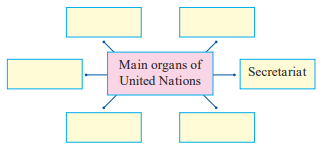The world since 1945 – I
(A) Choose the correct alternative and complete the following statements.
1. In 1949, China became a communist country under the leadership of Mao Zedong. (Krushchev, Mao Zedong, Joseph Stalin, Ho Chi Minh)
2. The principle of peaceful co-existence was put forth by Khrushchev. (Eisenhower, Joseph Stalin, Khrushchev, Jawaharlal Nehru)
(B) State the appropriate concept for the given statement.
1. Period of dominance of European powers: Eurocentrism
2. Conflict between America and Soviet Union: Cold War
(C) Find the odd word in the given set.
1. Hungary, Romania, Bulgaria, France
(France is the odd word because Hungary, Romania, and Bulgaria were under Soviet influence in Eastern Europe, while France was under Western influence.)
2. Italy, Poland, Spain, Greece
(Poland is the odd word because Italy, Spain, and Greece were under Western influence, while Poland was under Soviet influence in Eastern Europe.)
2. (A) Complete the concept map.
Answer:
- General Assembly
- Security Council
- Economic and Social Council
- Trusteeship Council
- International Court of Justice
- Secretariat
(B) Observe the given map and answer the following questions.
(Referring to the map of Division of Europe after World War II)
(i) Name two East European countries under the influence of Soviet Union:
Poland
Hungary
(ii) Name two West European countries under the influence of United States:
West Germany
France
3. State whether the following statements are true or false with reasons.
1. After the Bolshevik Revolution, Soviet Russia became a capitalist nation.
False.
Reason: After the Bolshevik Revolution of 1917, Soviet Russia adopted a socialist ideology and established a socialist state, not a capitalist one.
2. The Bandung Conference brought cold war in Asia.
False.
Reason: The Bandung Conference of 1955 aimed to promote goodwill, cooperation, and regionalism among Asian and African countries. It did not bring the Cold War to Asia but sought to address common issues and promote peace.
4. Answer the following.
1. Explain the term regionalism.
Answer: Regionalism refers to the process where countries from a specific geographic region cooperate to promote their collective national interests. It involves forming groups or organizations to address common issues like economic development, security, or cultural exchange, fostering a shared identity. Examples include the European Union (EU), ASEAN, and SAARC.
2. Discuss the role of United Nations.
Answer:
The United Nations (UN), established in 1945, plays a vital role in global affairs:
Maintain International Peace and Security: The UN works to prevent conflicts, mediate peace agreements, and deploy peacekeeping missions.
- Protect Human Rights: It promotes human rights through documents like the Universal Declaration of Human Rights (1948).
- Deliver Humanitarian Aid: The UN coordinates relief efforts during natural or man-made disasters.
- Promote Sustainable Development: It encourages prosperity, social well-being, and environmental protection.
- Uphold International Law: The UN supports legal frameworks through courts, treaties, and the Security Council.
5. Answer the following in detail with reference to the given points.
Elaborate the dimensions of Cold War.
The Cold War was a period of tension between the United States and the Soviet Union without direct warfare. Its dimensions include:
(a) Political:
The Cold War involved a struggle for political influence over Europe. Eastern European countries like Poland, Hungary, and East Germany were under Soviet control, while Western European nations like West Germany, France, and the UK were influenced by the United States. This led to a clear division of Europe into two blocs, with countries like Finland opting for neutrality to avoid conflict.
(b) Ideological:
The Cold War was marked by a clash between two ideologies: socialism in Eastern Europe, led by the Soviet Union, and capitalism in Western Europe, led by the United States. Eastern countries adopted socialist governments, while Western nations followed democratic systems, creating a deep ideological divide.
(c) Economic:
Economic systems differed significantly. Eastern European countries under Soviet influence followed a socialist economic model, where the government controlled major industries. In contrast, Western European countries under U.S. influence adopted a capitalist economy, where the private sector played a dominant role, leading to economic competition between the blocs.
(d) Security:
Security concerns led to the formation of military alliances. The North Atlantic Treaty Organization (NATO), formed in 1949, united Western Europe and the United States to counter Soviet threats. The Warsaw Pact, created in 1955, allied the Soviet Union and Eastern European countries to counter NATO. These alliances heightened tensions, as both sides prepared for potential conflict.


Leave a Reply